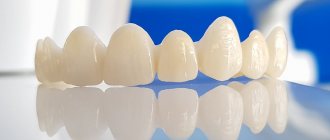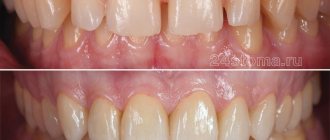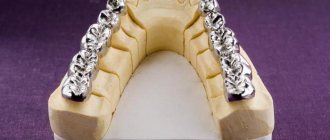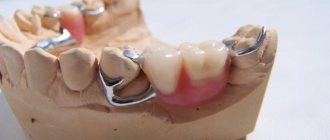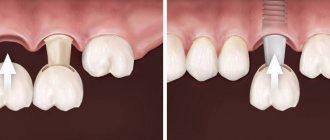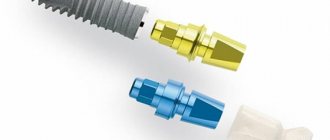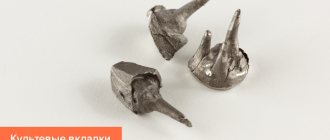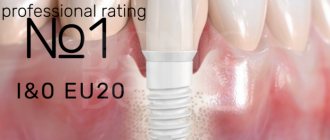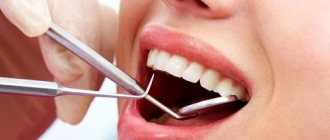Advantages and disadvantages
Advantages:
- high biocompatibility of the material - does not cause allergic reactions, reduces the period of adaptation of soft tissues;
- its optical properties are close to natural teeth - it has the same color, transparency, and reflective ability;
- the smooth surface prevents the accumulation of bacterial plaque;
- supports soft tissues well, forms the correct gum contour;
- minimizes the risk of cement leakage under the gum;
- durability.
Flaws:
- the palette includes only two shade options: bright white, dark yellow;
- high cost of all-milled models.
Complaints of periodic pain when chewing under old crowns
Before
After
Specialists:
Nazaryan David Nazaretovich
Description:
The patient came to the clinic on recommendation. Previously, he was treated at a third-party clinic, but did not seek dental care for a long time. At the time of treatment, he complained of periodic pain when chewing under old crowns on the lower jaw. The patient's desire was to improve chewing efficiency, get rid of pain, and also get a bright, expressive smile.
After a comprehensive diagnosis, an individual treatment plan was drawn up, which included the installation of dental implants in the chewing region of the lower and upper jaw. After this, carry out a complete therapeutic sanitation of all teeth and subsequently carry out functional and aesthetic prosthetics. After the implants were implanted, the bite was diagnosed and the optimal position of the lower jaw was determined. Based on the data obtained, a wax model of the dentition was created that met the aesthetic and functional requirements of the patient. To complete the complex treatment of this case, the patient received separate ceramic restorations for all teeth and dental implants.
What types are used for dental implantation?
- Standard - since personal parameters are not observed during production, the structures are not able to replicate the shape of the tooth and gums, which sometimes reveals their artificial origin.
- Individual - made from personal impressions. In this case, the anatomy of the patient’s dentofacial apparatus is taken into account to ensure a tight fit to the elements of the implantation system and gum tissue.
Standard models of zirconium abutments, manufacturers
- Nobel Biocare (Switzerland) is the main manufacturer of dental implants and components. The catalog includes superstructures made of titanium, zirconium and gold alloys.
- Astra Tech (Sweden) - creates corner and straight models using its own developed technologies. The products are perfectly combined with crowns made of any materials.
- Xive (Germany) - offers abutments made of biocompatible materials.
- Osstem (South Korea) - produces implants, superstructures and surgical instruments .
- Ankylos is a German manufacturer that produces straight and angled zirconium abutments.
- Alpha Bio is an Israeli company. The line contains a wide selection of suprastructures made of titanium and thermoplastic polymer with different methods of fixation. Zirconium is presented in a straight configuration.
- Mis is an Israeli company whose catalog includes connecting elements with a standard platform and with the possibility of switching.
Custom zirconia abutment: manufacturing and fixation
Zirconium is not noticeable under a ceramic crown, is resistant to chewing loads, and does not change its original properties throughout its service life. The material is compatible with CAD/CAM computer modeling .
Stages of installing an individual connecting element:
- After inserting the implant and attaching the plug, impressions are taken from the jaw.
- The manufactured model is scanned and transferred to the modeling program.
- An abutment is cut out from a single piece of zirconium dioxide using a computerized machine using CAD/CAM technology.
- The finished structure is fixed to the implant with cement or a screw.
«
Material
The production of individual abutments is in demand, since dentists claim that this type of design is more reliable. For their manufacture, zirconium dioxide is used, which has maximum similarity to a natural tooth, is durable, compatible with the body, and also has a long service life.
When using a zirconium connector, the shape of the gum is correctly restored after implantation; bacteria do not develop on zirconium. The tooth is easy to install. Subsequently, the denture is no different from other teeth, since it is overgrown with gum, which does not happen when using metal.
Which is better: titanium, gold or zirconium
Characteristics of structures depending on the material:
- Titanium - titanium copes well with chewing loads, however, the aesthetics of the restoration will be far from natural, since the material tends to show through the crown.
- Gold Ceramic-On is an alloy with a high gold content of 98%. The finished structure is covered with ceramic mass containing natural minerals, which gives the restoration excellent aesthetics.
- Titanium with cemented zirconia part . The frame of the structure is made of titanium and bonded to an individual zirconium component. The ability to correct the structure and color of the secondary component allows you to achieve high attractiveness when replacing teeth.
- Full zirconium . Made from a monolithic block of zirconium dioxide. Does not cause allergic reactions. Thanks to the color of the material, which is close to the natural shade of the teeth, it does not show through the crown.
- resin abutments . They are used for restoration of the smile area with temporary cement-fixed structures. They can be installed for up to 6 months during implantation treatment.
Titanium can be seen through the gum, so titanium components are primarily used in masticatory restorations. For the frontal area, it is better to use abutments made of materials whose color matches the natural color of the teeth.
What is a dental implant?
A dental implant is an artificial tooth root, which is designed to replace a lost or so damaged tooth that it is no longer possible to restore it using the methods and means of therapeutic dentistry. It is installed in the bone tissue of the upper or lower jaw, integrated into it and becomes a complete replacement for the tooth root. Such an implant can become a replacement for one lost tooth, and can also be used as a support for subsequent prosthetics to restore multiple dentition defects.
The key concept in dental implantology is osseointegration. This is the process of fusion of the implant with the bone tissue into which it is placed. That is why the material for it is most often titanium or its alloys, which have high osseointegration rates. Thus, the implant is not just tightly installed in the upper or lower jaw, it grows into it and in this regard almost completely corresponds to the root of a regular tooth.
Currently, there are many forms and designs of dental implants, which allows the dentist to solve a variety of problems in various clinical situations. Many companies, both foreign and domestic, are involved in their development and production; due to competition between them, prices for dental implants have noticeably decreased in recent years.
What is an abutment in dentistry?
Almost any specialized Internet resource will tell you what an abutment is in dentistry, but it is quite difficult for an ordinary person to understand the endless variety of these orthopedic products and their capabilities. Let's start with the fact that all types of similar structures (with the exception of gum formers) have one common goal - to connect the implant and the crown. An implant without an abutment cannot perform its function. Moreover, the final result of treatment in terms of functionality and aesthetics largely depends on this important component. If at the dawn of implantology dentists had a rather narrow choice of prostheses, today almost all manufacturers produce several lines of orthopedic components. It is quite difficult for an ordinary person to understand the technical intricacies and design features of all types of abutments, but it will be useful to know their types.
History of zirconium implants
These dental systems became known to the world relatively recently, about 10 years ago. Currently, zirconium implants are produced by several manufacturers from Europe and the USA.
We are dealing with improved Straumann PURE zirconium models, characterized by an accelerated healing period and the possibility of fixation in case of insufficient bone tissue. In addition, such implants can be installed in persons prone to allergic reactions.
What is the difference between screw fixation of crowns on implants and cement, which is better?
First, we need to explain that with cement fixation we have an implant, to which an abutment is screwed with a screw, and a crown is placed on top of it on top of the cement, in fact, exactly the same as on your own tooth. With screw fixation, a crown is immediately made and fixed directly to the implant (without an abutment) with the same screw. This leaves a hole in the crown for the screw, which is closed with a conventional light filling material.
What's better? This question is akin to what is better: Mercedes or BMW, Canon or Nikon, Mac OS or Windows, Gucci or Prada... You should not contrast one type of prosthetic fixation with another. Although even among very advanced dentists there are ardent fans of one method or another, defending their position on the preferable use of one method over another. In fact, in my opinion, both of them have an equal right to life and selective use in certain conditions. Each has its own pros and cons. And I believe that in this matter the choice is up to the individual doctor. If he justified his choice to you, and you internally agree with his arguments, then simply trust. Otherwise, you can get to the point where you try to advise the implantologist during the implantation operation how to hold the tip correctly, what drills to choose, what thread to sew with, etc. In general, this usually only happens to one type of patient... the dentists themselves, when they find themselves on the other side of the drill machine.
And yet, if such a question arises, then for particularly interested patients I will very briefly explain the disadvantages of each fixation method.
Screw fixation of crowns to implants.
1. There is always a hole on the crown that has to be closed with composite. Aesthetics suffer from this. In addition, the hole of the screw shaft may be located on the tubercle, the cutting edge (in these areas frequent chipping of the composite covering the “hole” is possible) or the front surface of the front teeth (in this case there will be a clear failure in aesthetics).
2. With long bridges supported by implants, even with small inaccuracies in the frames (which happens quite often in our lives), screw fixation can give the doctor a false sense of confidence that everything fits “as it should, without gaps.” In fact, by “pulling” the frame of the crowns to the implants, the doctor concentrates a lot of stress on the fixing screws and then unpleasant problems are possible. For example, a screw may simply burst. And then getting it out of the implant is a big problem. All this can end quite sadly, up to the need to remove the “screw” with a piece of the fixing screw inside.
In this diagram: 1-implant, 2-abutment/crown, 3-fixing screw. The red arrow shows the location of the fixing screw inside the implant during screw fixation. Blue - possible fracture of the screw when tightening an inaccurately manufactured structure and, as a result, excessive stress is concentrated on the screw.
Cement fixation of crowns to implants.
1. One of the main disadvantages is that excess cement squeezed out when fixing the crown can form a thin film quite deep between the gum and the abutment. And this is one of the possible reasons for the development of peri-implantitis - inflammation of the bone tissue around the implant. Once this process starts, it is not so easy to stop it, and it can all end in the loss of the implant. And along with it, bone tissue to replace it with a new one.
This photo shows a crown cemented onto an abutment. The arrow shows a film of hardened cement, which can cause inflammation around the implant - peri-implantitis.
2. If the fit of the crown frame to the abutment is not very precise, the fixing cement may be washed away by saliva over time. The resulting gap will begin to be filled with soft plaque and oral bacteria. At best, this will end in easily correctable decementation and loss of the crown. In the worst case, again, there is a basis for the development of priimplantitis.
The arrows indicate the gaps between the crown and the abutment. If such a crown is cemented, after some time these cracks will become a storage area for soft plaque.
In fact, all the indicated disadvantages of both methods are easy for a knowledgeable doctor to circumvent. So let’s hope that you will get just such an orthopedist, and you will not have a headache on such a specific issue as choosing a method for fixing a crown to an implant.
Presence of root caries in teeth and severe dentoalveolar deformations
Before
Stages
After
Specialists:
Kyalov Grigory Georgievich
Description:
The patient came to the clinic on a recommendation from friends who had undergone successful implantological treatment at the NK Clinic.
After an initial consultation, X-ray examination and functional planning, it was proposed to remove teeth 38, 37, 47, 48 and 26. The reason is the presence of root caries in each tooth and severe dentoalveolar deformations, in the presence of which it is impossible to create an effective and correct chewing function. We removed the corresponding teeth and performed simultaneous dental implantation. Three months later, we produced separate ceramic crowns on individual zirconium abutments, supported by dental implants. Thus, we were able to completely restore chewing function.
Advantages and disadvantages of zirconium implants
Among the key advantages that zirconium implants have are:
- Excellent aesthetic parameters;
- Increased structural strength and long service life;
- Absolute compatibility with the body. There is no likelihood of negative consequences and pathological processes;
- Excellent initial stabilization of the structure. Due to this, the prosthetic device is fixed almost immediately after installation of the zirconium implant;
- The possibility of the root part being visible through the gum tissue is excluded, since it has a light tone;
- Installation of a zirconium implant is allowed even in the presence of degenerative processes in periodontal tissues;
- There is no possibility of shrinkage of the fixed implant, even in case of prolonged use;
- The possibility of the appearance of carious lesions and purulent lesions is excluded, which is due to the excellent antibacterial characteristics of zirconium material;
- Do not interfere with the ability of bone tissue to regenerate;
- Due to the low thermal conductivity of zirconium, the patient feels quite comfortable when eating hot foods;
- The maximum warranty period is over 15 years.
If we talk about the negative aspects that zirconium implants have, taking into account the reviews, we can come to the following conclusions:
- Zirconium implants have not been sufficiently studied, due to which there is a certain risk of complications after their fixation;
- A zirconium implant has an impressive cost.
It should be borne in mind that even despite the advantages of using this material, restoring a deep bite is impossible.
Indications for the use of zirconium implants
It should be noted that the production of dental implants from zirconium material is carried out using high-tech equipment. To model the basis of such structures, special software and a scanning device are used. Next, the information obtained is sent to milling equipment, which is used to produce the structure’s frame from a zirconium block. After this, a special coating with bioactive components is applied to the base. Particular attention should be paid to the shade of zirconium implants: it is light and closely resembles the enamel of a natural tooth.
Due to their unique characteristics and design solutions, the use of implants made of zirconium material is considered appropriate in the following situations:
- If the patient has allergic reactions to metal and titanium material;
- The possibility of the occurrence of pathological processes in the area of periodontal tissues;
- If necessary, provide a gentle effect on gum tissue;
- There is a need to recreate the aesthetic component of a smile. When installing zirconium structures in tandem with a metal-free prosthesis, it is possible to completely restore aesthetics;
- There is a need to fix the bridge prosthetic structure in the frontal region.
It is important to understand that zirconium implants are not used as often as their titanium counterparts, but choosing them is advisable in specific cases.
The specialists of the Implantmaster clinic focus on the implementation of modern solutions in the field of implantation. We offer zirconium implants in situations where it is necessary to obtain an impeccable aesthetic result, or when the patient has increased sensitivity to titanium structures, as well as in the absence of sufficient bone tissue. At the same time, our doctors have the skills to use innovative diagnostic equipment and often resort to the help of high-precision surgical templates.
Price of zirconium implants at Implantmaster
As is known, zirconium material is significantly expensive. Moreover, modern high-tech technology is used in the production of dental products from it. Also, the process of implant installation itself is characterized by significant labor intensity. In addition, when choosing zirconium implants, you should remember that the turnkey price is affected by the material from which the prosthesis is made. Typically, the prosthetic device is made from solid ceramic or zirconium.
Our dentistry offers impressive discounts on the best zirconium implants, since we work directly with their manufacturers. Our specialists also focus on the financial capabilities and preferences of patients.
Possible complications after implantation
It is necessary to understand that even if you are offered the best zirconium implants, the likelihood of complications after surgery will always be present. Therefore, you should contact top-level specialists for such treatment who know the intricacies of fixing zirconium implants. With an incompetent approach, mistakes are possible that can lead to severe pain, increased body temperature and chills. In addition, some discomfort may be felt during osseointegration of the zirconium structure. This is considered a normal reaction during the period of adaptation of the body to new material.
Author:
Monolithic zirconium implants with abutment
A characteristic feature of zirconium implants is their solidity. This indicates that the transition element and the body of the product are combined into a solid structure. It should be noted that fixing zirconium implants for a long time was problematic. The most problematic area was the connection between the body and the adapter, and the fixing screw, made of zirconium material, was somewhat fragile. Due to the weakening of the connection as chewing pressure is applied, the prosthetic device could move out or, for example, a screw could fracture. This, in turn, involves the need to replace the dental implant, which requires significant effort and expense.
With the development of monolithic zirconium PURE structures from Straumann, the issue of low bond strength has disappeared. It was possible to obtain an improved version of the thread and heterogeneity in the body of the structure. In addition, it became possible to prepare the upper supragingival part.
